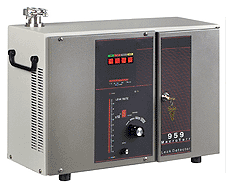Leak Testing Equipment Information

Leak testing equipment is used to measure the escape of liquids, vacuum or gases from sealed components or systems. Some configurations require a separate leak detector or sensor as an input. Such types of leak testing equipment are often equipped with various other components such as pumps, calibrators, gauges and cases.
Specifications
Output options include analog voltage, analog current, frequency or modulated frequency, and switch or alarm signal. Some leak testing equipment includes an analog front panel with potentiometers, dials, and switches. Other features a digital front panel that is set up with a keypad or menus. Leak testing equipment with a serial interface, a parallel interface, and/or integral application software is also available.
Test Methods
Leak test method is an important specification to consider when choosing leak testing equipment. Methods include bubble testing, colorimetric development, electronic gas detection, mass flow, mass spectrometry,hydrogen leak detection, pressure differential (decay), and ultrasonic leak detection.
- Bubble testing is used for applications which do not require high sensitivity. A pressurized test object is submerged in a water tank so that the emergence of bubbles indicates a leak.
- Colorimetric development uses a chemical developer which reacts with the leaking fluid, causing a visible color change to occur at the place of leakage.
- Leak testing equipment that uses electronic gas detection pressurizes the test object with a tracer gas so that a sniffer probe can be used to find the leak.
- Mass flow devices direct the leakage across a heating element. The temperature change produces an output voltage proportional to mass flow.
- Mass spectrometers are used with helium leak detection.
- Leak testing equipment that is designed to detect hydrogen leaks is also available.
- A pressure decay test involves the initial inflation of the test object and the establishment of a reference pressure. After a designated amount of time, the pressure is measured again and the initial and final measurements are compared. The change in pressure can be used to calculate the leak rate given the internal volume of the device.
-
Ultrasonic leak detection (sonic flow, choked flow) involves the turbulent flow of a fluid across a pressure boundary to create acoustic waves. These waves are transmitted through the medium of the fluid itself, through the containment structure, or through the air surrounding the containment structure. Leak testing equipment that uses other test methods is also available.
Standards
The American Society for Testing and Materials (ASTM) provides several standards for various types of leak testing procedures including the following:
ASTM E1003 — Standard practice for hydrostatic leak testing.
ASTM F2095 — Standard test methods for pressure decay leak test for flexible packages with and without restraining plates.
ASTM E498/E498M — Standard practice for leaks using the mass spectrometer leak detector or residual gas analyzer in the tracer probe mode.
Resources
Image credit:
Agilent Technologies Inc.
- Arizona
- California
- Colorado
- Connecticut
- Delaware
- Florida
- Georgia
- Illinois
- Indiana
- Kentucky
- Louisiana
- Massachusetts
- Maryland
- Michigan
- Minnesota
- Missouri
- North Carolina
- New Hampshire
- New Jersey
- New York
- Ohio
- Oklahoma
- Oregon
- Pennsylvania
- South Carolina
- Tennessee
- Texas
- Utah
- Virginia
- Washington
- Wisconsin
- Analog Current
- Analog Front Panel
- Analog Meter or Indicator
- Analog Voltage
- Application Software Included
- Audible Alarm Option
- Computer Interface
- Digital Front Panel
- Digital Readouts
- Electronic Gas Detection
- Frequency / Modulated Frequency
- Mass Extraction
- Mass Flow
- Mass Spectrometer (Helium Leak Detector)
- Memory Capability or Data Logging
- Parallel Interface
- Pressure Differential / Decay
- Self-calibrating
- Serial Interface
- Switch or Alarm Signal
- Timer
- Trigger Options
- Ultrasonic Leak Detector
- Video Display Terminal
- vacuum leak tester
- gas leak detection
- water leak detection equipment
- air leak testing equipment
- bubble leak testing
- gas leak testing equipment
- helium leak detectors
- helium leak testing equipment
- Hydrogen Leak
- snoop leak detection
- tension meter paper machine
- vacuum leak testing equipment
- color sensor development kit
- ultrasonic leak testing equipment
- gross leak testers
- HVAC duct leak testing equipment
- packaging leak testers
- pressure leak testers
- uson air leak testers
- uson leak testers
- vacuum box leak testing equipment
- valve leak testers
